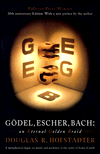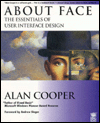 Godel, Escher, Bach: an Eternal Golden Braid
Godel, Escher, Bach: an Eternal Golden BraidI have read so many books that it's hard to pick favorites, but here are a few books I recommend. (You can click on any of the book pictures to get more info or buy the book.)
 Godel, Escher, Bach: an Eternal Golden Braid
Godel, Escher, Bach: an Eternal Golden Braid
This 700+ page book is by far the most impressive work of nonfiction I have ever seen. It is not an easy read, but does have entertainment value nevertheless. It deals with lots of subjects, mostly revolving around the general concept of "strange loops", such as the chicken-egg problem, or DNA creating us creating DNA.
This book won the Pullet Surprise; I am not sure what this is, but it may be a chicken on rice dish with a slab of melted cheese on top.
This old book about multidimensionality and geometry is available in a variety of different formats. In an entertaining, Lewis-Carroll--like way, it gives valuable insight into multidimentionality.
Of all the books about utopian or dystopian future governments, this book by Aldous Huxley is my favorite. Very cleverly done.
This book is not only arguably Robert A. Heinlein's best, it is easily one of the best science fiction books ever written.
Now reissued under the title "Mr. Tompkins in Paperback", this book by Nobel Prize-winning physicist George Gamow explains general relativity in a very simple, accessible, and pleasant manner. Not having anything better to do, Mr. Tompkins attends weekly physics lectures at a nearby university; he promptly falls asleep at each one, each time having a dream wherein one or more physical constants (such as the speed of light) are drastically changed (such as to 10 MPH) so that relativistic effects are easily observable and explainable. Recommended reading at the high school level or above.
 About Face: The Essentials of User Interface Design
About Face: The Essentials of User Interface Design
(Alan Cooper / IDG Books / Jan 1995)
This book about software design provides a unique insight into what makes a computer program good or bad to use. Frequently I wish that the designers of the software I use had read this book (they obviously haven't).